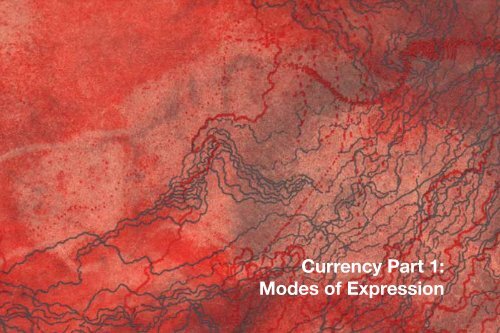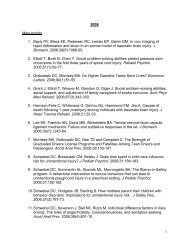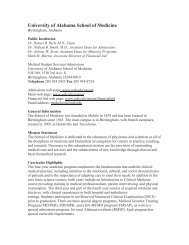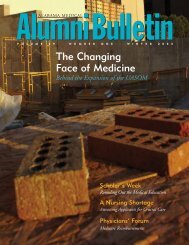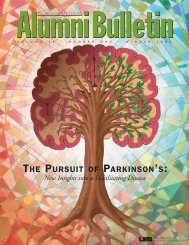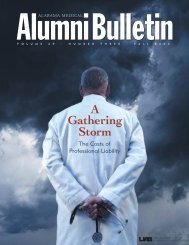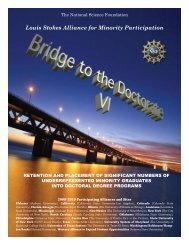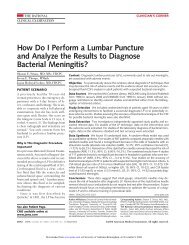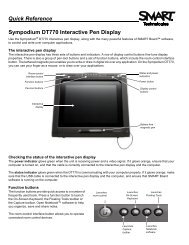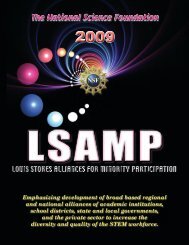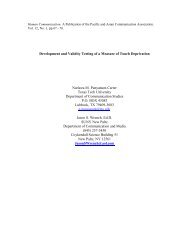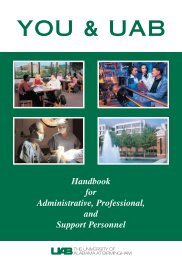+ Currency Part 1 - University of Alabama at Birmingham
+ Currency Part 1 - University of Alabama at Birmingham
+ Currency Part 1 - University of Alabama at Birmingham
You also want an ePaper? Increase the reach of your titles
YUMPU automatically turns print PDFs into web optimized ePapers that Google loves.
Jürgen Tarrasch<br />
<strong>Currency</strong> <strong>Part</strong> 1:<br />
Modes <strong>of</strong> Expression<br />
Artifacts
<strong>Currency</strong> <strong>Part</strong> 1:<br />
Modes <strong>of</strong> Expression<br />
cur<strong>at</strong>ed by Derek Cracco and Brett Levine
Introduction<br />
<strong>Currency</strong> <strong>Part</strong> 1: Modes <strong>of</strong> Expression and <strong>Currency</strong> <strong>Part</strong> 2: Means <strong>of</strong> Exchange are exhibitions<br />
driven by a spirit <strong>of</strong> collabor<strong>at</strong>ion and the desire to critically interrog<strong>at</strong>e contemporary printmaking<br />
practices, To give credit where it is due, the initial impetus for the exhibition came from Pr<strong>of</strong>essor<br />
Derek Cracco <strong>at</strong> the <strong>University</strong> <strong>of</strong> <strong>Alabama</strong> <strong>at</strong> <strong>Birmingham</strong>. His commitment to contemporary<br />
printmaking and his belief th<strong>at</strong> we had an oblig<strong>at</strong>ion to explore these practices led to the two<br />
projects th<strong>at</strong> comprise the series.<br />
<strong>Currency</strong> <strong>Part</strong> 1: Modes <strong>of</strong> Expression is positioned by both abstraction and the interrog<strong>at</strong>ion <strong>of</strong><br />
media. <strong>Currency</strong> <strong>Part</strong> 2: Means <strong>of</strong> Exchange, which will be explored in a separ<strong>at</strong>e public<strong>at</strong>ion,<br />
considers the roles th<strong>at</strong> contemporary print practices have in medi<strong>at</strong>ing our expriences <strong>of</strong> the<br />
world through the examin<strong>at</strong>ion and interpret<strong>at</strong>ion <strong>of</strong> currency itself.<br />
These exhibitions highlight our commitment to the UAB Visual Arts Gallery and Artlab’s ongoing<br />
focus on contemporary practices th<strong>at</strong> have the potential to change the ways we look <strong>at</strong> the world,.<br />
Brett Levine<br />
Director, Artlab/The Visual Arts Gallery
The Simplicity <strong>of</strong> Multiplicity<br />
by Brett M. Levine<br />
Printmaking’s complexity, as well as its simplicity, lies is its multiplicity. The<br />
capacity for seriality and repetition places printmaking in a class <strong>of</strong> artistic<br />
practices th<strong>at</strong> sits uneasily within the fine arts precisely because <strong>of</strong> this capacity.<br />
The idea <strong>of</strong> repetition being an an<strong>at</strong>hema to fine arts is as common a st<strong>at</strong>ement as<br />
is Walter Benjamin’s observ<strong>at</strong>ions on the aura, authenticity and originality.<br />
I begin here because the two exhibitions th<strong>at</strong> form the season <strong>of</strong> <strong>Currency</strong> are<br />
framed not by this idea, but instead by a framework th<strong>at</strong> is both far simpler, and<br />
perhaps more complex <strong>at</strong> the same time.
<strong>Currency</strong> <strong>Part</strong> 1: Modes <strong>of</strong> Expression is, in many ways, a very traditional<br />
exhibition. It contains the largest collection <strong>of</strong> contemporary print works made<br />
with traditional media th<strong>at</strong> has ever been exhibited <strong>at</strong> Artlab. And, in many<br />
ways, this observ<strong>at</strong>ion was initially an impediment. My reserv<strong>at</strong>ions stemmed<br />
in part from my own inability to critically position printmaking as a contemporary<br />
discursive practice, a reserv<strong>at</strong>ion th<strong>at</strong> was dispelled by my convers<strong>at</strong>ions with<br />
pr<strong>of</strong>essor and printmaker Derek Cracco. My reticence was exacerb<strong>at</strong>ed by wh<strong>at</strong><br />
I perceived as printmaking’s emphasis on technique – something th<strong>at</strong> while not<br />
unimportant, was not and still is not my primary criterion for evalu<strong>at</strong>ing a work <strong>of</strong><br />
art. Here is a contemporary dilemma, one in which I perceived th<strong>at</strong> the value <strong>of</strong>
a work could not be derived from its medium or methodology, but was instead<br />
wholly dependent on its concept.<br />
I believe this belief, which I acknowledge can border on a prejudice, stems in part<br />
from the historicity th<strong>at</strong> accompanies so much printmaking today. It is difficult,<br />
for example, not to consider the practices <strong>of</strong> printmaking as falling somehow<br />
outside the fine arts realm. Consider, for example, an exhibition from the early<br />
1990s th<strong>at</strong> appeared in London, Philadelphia, and Canberra, Australia. It’s title?<br />
Lasting Impressions: Lithography as Art. The title implies, by necessity, th<strong>at</strong><br />
maybe lithography (and by extension every other print medium), might somehow<br />
not really be art – it might be a commercial practice, or a practice so trapped in
its industrial/commercial applic<strong>at</strong>ions th<strong>at</strong> wh<strong>at</strong>ever it was it would never scale the<br />
heights <strong>of</strong> the true fine arts – painting, sculpture and architecture, <strong>of</strong> course.<br />
We know, <strong>of</strong> course, th<strong>at</strong> this is not the case. We accept th<strong>at</strong> the print medium<br />
has not only expanded our experiences <strong>of</strong> art, but th<strong>at</strong> it has also opened its<br />
market. We see the screenprints <strong>of</strong> Andy Warhol, the transfer prints <strong>of</strong> Roy<br />
Lichtenstein, and the etchings <strong>of</strong> Kiki Smith as works th<strong>at</strong> assert the primacy and<br />
the possibility <strong>of</strong> modern and contemporary printmaking.<br />
I begin here because it is from this framework th<strong>at</strong> <strong>Currency</strong> <strong>Part</strong> 1: Modes <strong>of</strong><br />
Expression was conceived. When Derek Cracco first posited the idea, it was
framed in the ways I have outlined above. I believed th<strong>at</strong> there was duplicity in<br />
the concept much as there was duplicity in the idea <strong>of</strong> printmaking itself. It seems<br />
self-evident th<strong>at</strong> the very process <strong>of</strong> printmaking, the cre<strong>at</strong>ion <strong>of</strong> a copy without<br />
an original, cre<strong>at</strong>es something th<strong>at</strong> is unique and universal in precisely the same<br />
instant.<br />
Wh<strong>at</strong> follows, then, is an exhibition th<strong>at</strong> explores the notion th<strong>at</strong> printmaking stands<br />
as a trope for the contemporary cre<strong>at</strong>ive practice. One could read the media<br />
themselves as being subject to a single question, which became “Wh<strong>at</strong> does it<br />
mean to express an idea through the practice <strong>of</strong> a printmaking medium today?”<br />
Wh<strong>at</strong> is, and wh<strong>at</strong> do we mean, when we speak <strong>of</strong> its mode <strong>of</strong> expression?
The six artists in <strong>Currency</strong> <strong>Part</strong> 1: Modes <strong>of</strong> Expression, each have an individual<br />
approach to a medium and a methodology. Five <strong>of</strong> the six artists are represented<br />
through their emphasis on abstraction, while the sixth explores a terrain<br />
somewhere outside pure abstraction itself.<br />
Consider, initially, the three works by Polly Apfelbaum. Each is a lithograph, a<br />
work made possible by the n<strong>at</strong>ural opposition <strong>of</strong> oil and w<strong>at</strong>er and the capacity<br />
this cre<strong>at</strong>es for binding ink to a pl<strong>at</strong>e. Apfelbaum’s iconography is both simple<br />
and familiar. She began drawing and printing flowers almost twenty years<br />
ago, initially by simply sketching some <strong>of</strong> Warhol’s flowers. This unexpected
appropri<strong>at</strong>ion stands as indic<strong>at</strong>ive <strong>of</strong> printmaking itself. Apfelbaum subtly<br />
appropri<strong>at</strong>ed and altered one <strong>of</strong> history’s grand appropri<strong>at</strong>ors, recontextualizing<br />
the imagery to be delic<strong>at</strong>e and intim<strong>at</strong>e. The flower, as a fl<strong>at</strong> block <strong>of</strong> unified color,<br />
stands as a symbol for n<strong>at</strong>ure far more than it actually represents n<strong>at</strong>ure itself.<br />
Rainbow Love, Mountain Ranch, New Mexico is a twelve-color lithograph th<strong>at</strong><br />
arrays itself vertically in terms <strong>of</strong> color but horizontally iconographically. Her flower<br />
theme, a consistent element in her works for over twenty years, provides a constant<br />
yet ever changing element th<strong>at</strong> can serve to unify her works. In When Opposites<br />
Attract we see two approaches to the monochrome represent<strong>at</strong>ion <strong>of</strong> a unified<br />
subject. On the left, we see wh<strong>at</strong> we might regard as the gesture, while on the right<br />
we find her marks reduced to the fl<strong>at</strong> blocks <strong>of</strong> color th<strong>at</strong> appear in other works.
These l<strong>at</strong>ter icons are, in a sense, more indic<strong>at</strong>ive <strong>of</strong> the modernity <strong>of</strong> printmaking,<br />
while the former refer to its history.<br />
Artist Laura Berman’s works from both her Gridrocks and her Rockpiles series<br />
consider the rel<strong>at</strong>ionships between the form and p<strong>at</strong>tern <strong>of</strong> n<strong>at</strong>ure and the essential<br />
fl<strong>at</strong>ness <strong>of</strong> printmaking. Writing on the Gridrocks, a series <strong>of</strong> relief monoprints,<br />
Berman has observed th<strong>at</strong> the works are inspired by both the permanence and<br />
whimsy th<strong>at</strong> cohabit<strong>at</strong>e in her rock collection. Formally, the pieces are ambiguous,<br />
a series <strong>of</strong> organically shaped, multicolored shapes arrayed across a sheet <strong>of</strong> paper.<br />
Berman’s monoprints are the only ones in the exhibition. Perhaps the single most<br />
challenging element <strong>of</strong> these pieces is th<strong>at</strong> in representing the rocks Berman’s
eductions make their lineages more hidden. The idea <strong>of</strong> the rock as a subject<br />
cre<strong>at</strong>es an autom<strong>at</strong>ic dichotomy, one between the beauty <strong>of</strong> n<strong>at</strong>ure (where the rock<br />
signifies both groundedness and permanence), and the shortsightedness <strong>of</strong> the<br />
narrow minded (in which someone might be ‘dumb as a box <strong>of</strong> rocks’).<br />
Carl Fudge’s screenprints combine aspects <strong>of</strong> historical art, contemporary<br />
technology, and traditional printmaking techniques to cre<strong>at</strong>e works th<strong>at</strong> refuse to be<br />
historicist while <strong>at</strong> the same time being historical. The significance <strong>of</strong> these works<br />
lies not in our capacity to recognize their source m<strong>at</strong>erial, as it is not about whether<br />
or not we can loc<strong>at</strong>e the pieces comfortably. Instead, Fudge’s transform<strong>at</strong>ion <strong>of</strong><br />
the source m<strong>at</strong>erial into a series <strong>of</strong> pieces, which are represented by variables –x,
y and z –, means th<strong>at</strong> the works themselves become both singular and universal.<br />
Our expect<strong>at</strong>ion, or even Fudge’s assertion th<strong>at</strong> the pieces actually have a historical<br />
framework hinges on our complicity in believing this to be the case. Wh<strong>at</strong> is most<br />
challenging, and therefore most unexpected, is th<strong>at</strong> screenprinting has so <strong>of</strong>ten<br />
been used as a medium <strong>of</strong> pop and post-pop reduction, something suited for both<br />
Warholian excess and garage band success.<br />
More unexpectedly, Fudge’s nomencl<strong>at</strong>ure cre<strong>at</strong>es a kind <strong>of</strong> expect<strong>at</strong>ion th<strong>at</strong> the<br />
works themselves have identifiable sources. A brief search suggests antecedents<br />
might be Lazlo Moholy-Nagy’s Komposition Z, or although seemingly less likely,<br />
Wassily Kandinsky’s Komposition X. Fudge’s abstractions become complex studies
in p<strong>at</strong>tern and repetition, multilayered works th<strong>at</strong> obscure their primary sources and<br />
become something more than pure abstraction <strong>at</strong> the same time.<br />
Kevin Haas’ Inventory series shares much with Klingberg’s Brand New View.<br />
The most represent<strong>at</strong>ive <strong>of</strong> the works in the exhibition, Haas has still distilled<br />
his iconography to its simplest elements. The black silhouettes highlight the<br />
unexpected subtleties <strong>of</strong> design, and the works represent objects th<strong>at</strong> are<br />
traditionally found <strong>at</strong> human scale. Haas’ focus on traditional printmaking<br />
techniques highlights the absolute banality <strong>of</strong> the subjects themselves. The works,<br />
intaglios on paper, capture subjects th<strong>at</strong> would not seem to merit such complex<br />
tre<strong>at</strong>ments. In this disparity, Haas distills one <strong>of</strong> the focus areas <strong>of</strong> contemporary
printmaking to its simplest elements. Whereas historically printmaking allowed<br />
members <strong>of</strong> a social structure to assert st<strong>at</strong>us and power, contemporary<br />
printmakers use complex techniques to represent quotidian objects. For<br />
<strong>Currency</strong> <strong>Part</strong> 1, Haas’ nine-piece grid <strong>of</strong> objects from the everyday world almost<br />
cre<strong>at</strong>es a taxonomy <strong>of</strong> the overlooked. Like Klingberg, the capacity <strong>of</strong> the banal<br />
becomes the celebr<strong>at</strong>ion <strong>of</strong> unexpected beauty.<br />
At first, both the beauty and the seemingly obsessive qualities <strong>of</strong> cre<strong>at</strong>ion inherent<br />
in Karla Hackenmiller’s works are not necessarily apparent. Liminal Collision, an<br />
etching and spit bite aqu<strong>at</strong>int, is a delic<strong>at</strong>e abstraction with threads etched across<br />
the pl<strong>at</strong>e. The Liminal Slices combine etching and collage, adding an unexpected
texture to our expect<strong>at</strong>ions <strong>of</strong> the print. This unexpectedness is represented<br />
through the collision and passage <strong>of</strong> inform<strong>at</strong>ion across the ground, much as the<br />
way in which the idea <strong>of</strong> the liminal and liminality address the space one inhabits<br />
between two st<strong>at</strong>es – between conscious and unconscious, or between asleep and<br />
awake. Hackenmiller uses traditional methods to represent universal experiences<br />
th<strong>at</strong> are more <strong>of</strong>ten illustr<strong>at</strong>ed through the moving image.<br />
Gunilla Klingberg’s Brand New View is the least traditional print work in <strong>Currency</strong><br />
<strong>Part</strong> 1, <strong>at</strong> least to the extent th<strong>at</strong> it lacks a traditional ground. Her large-scale,<br />
site-specific works turn mundane corpor<strong>at</strong>e identities and well-known corpor<strong>at</strong>e<br />
brands into large-scale rosettes or mandalas, icons for a new view <strong>of</strong> the corpor<strong>at</strong>e
age. For Brand New View, she hybridizes American and intern<strong>at</strong>ional corpor<strong>at</strong>ions,<br />
familiar brands like Wal-Mart or Target. The former’s <strong>of</strong>t-overlooked star becomes<br />
a repetitive signifier <strong>of</strong> success and glamour, while the l<strong>at</strong>ter’s ubiquitous target<br />
icon serves to cre<strong>at</strong>e dynamism and movement. Kmart’s oversized K becomes<br />
transformed into something suggesting the Indian subcontinent, while the<br />
Northeastern supermarket chain Shoprite makes an appearance with its former<br />
logo, still in use <strong>at</strong> some loc<strong>at</strong>ions. Klingberg’s install<strong>at</strong>ion makes the banal<br />
become beautiful, as the texts and embellishments become transformed into<br />
p<strong>at</strong>terns suggestive <strong>of</strong> a higher value. One need only walk a short distance to<br />
the stained glass rosette window on the UAB campus to see an antecedent th<strong>at</strong><br />
is both transformed and skewered by Klingberg’s repurposing <strong>of</strong> such iconic
logos. The vinyl serves to stand as one <strong>of</strong> the most contemporary approaches<br />
to printmaking. Its capacity for boundless design and endless identical<br />
represent<strong>at</strong>ion means th<strong>at</strong> it shares the process <strong>of</strong> printmaking <strong>at</strong> least as closely<br />
as it strays from printmaking’s traditional media.<br />
For now, <strong>Currency</strong> <strong>Part</strong> 1: Modes <strong>of</strong> Expression serves as a tent<strong>at</strong>ive step<br />
towards reconsidering and recontextualizing contemporary printmaking. It<br />
seeks to work <strong>at</strong> the edges, to question the roles <strong>of</strong> traditional media as mark<br />
making methods in the modern world. Obviously each artist is committed to the<br />
potentials th<strong>at</strong> traditional mark making provides in the printmaking context. But<br />
r<strong>at</strong>her than be constrained by media, these artists take control <strong>of</strong> both the media
and their histories to assert new ways <strong>of</strong> using well-understood tools.<br />
Perhaps each <strong>of</strong> these artists explores a duality th<strong>at</strong> might not have readily been<br />
apparent. Fudge and Klingberg explore the intersections <strong>of</strong> technology and<br />
tradition. Berman and Apfelbaum sit on the edges <strong>of</strong> n<strong>at</strong>ure and process. Kevin<br />
Haas uses the contemporary world as a means <strong>of</strong> abstraction, and printmaking<br />
as its method. And Karla Hackenmiller allows the spaces <strong>of</strong> transition, the liminal<br />
spaces, to be both reflected upon and represented through both her process and<br />
content.<br />
Clearly contemporary printmaking allows us to process this ongoing process,
th<strong>at</strong> <strong>of</strong> thinking historically without historicizing it. Printmaking may be the<br />
most ubiquitous artform we encounter each day. Perhaps it is more pervasive<br />
than photography. In any event, it is time to rescue it from its consignment to<br />
history, and to understand th<strong>at</strong> tradition and traditional are not the same thing.<br />
Instead, printmaking has a currency as a mode <strong>of</strong> expression th<strong>at</strong> is defining our<br />
understandings <strong>of</strong> the world and its expression today.
List <strong>of</strong> Works<br />
p.2: Kevin Haas, from the Inventory series, Intaglio on Paper, courtesy <strong>of</strong> the artistp 4: Polly Apfelbaum, When<br />
Opposites Attract, One Color Lithograph, courtesy the artist and Tamarind Institute<br />
p 6: Polly Apfelbaum, Rainbow Liove, Mountain Ranch, New Mexico, Twelve Color Lithograph, courtesy the<br />
artist and Tamarind Institute<br />
p 8: Polly Apfelbaum, Flower P<strong>at</strong>ch, Two Color Lithograph, courtesy the artist and Tamarind Institute<br />
p 10: Laura Berman, Rockpiles 2 (1), Monoprint, courtesy <strong>of</strong> the artist<br />
p 12: Laura Berman, Rockpiles 2 (10), Monoprint, courtesy <strong>of</strong> the artist<br />
p 14: Laura Berman, Gridrocks #16, Monoprint, courtesy <strong>of</strong> the artist<br />
p 16: Carl Fudge, Komposition Y, Three Color Screenprint, courtesy the artist and Ronald Feldman Gallery, New<br />
York<br />
p 18: Carl Fudge, Komposition Z, Three Color Screenprint, courtesy the artist and Ronald Feldman Gallery,<br />
New York<br />
p 20: Kevin Haas, Inventory: Shopping Cart, Intaglio on Paper, courtesy <strong>of</strong> the artist<br />
p 22: Kevin Haas, Inventory: Gener<strong>at</strong>or with Lights, Intaglio on Paper, courtesy <strong>of</strong> the artist<br />
p 24: Kevin Haas, Inventory: Caution, Intaglio on Paper, courtesy <strong>of</strong> the artist<br />
p 26: Karla Hackenmiller, Liminal Collision, Etching and Spit Bite Aqu<strong>at</strong>int, courtesy <strong>of</strong> the artist<br />
p 28: Karla Hackenmiller, Liminal Fracture #14, Etching and Collage, courtesy <strong>of</strong> the artist<br />
p 30: Karla Hackenmiller, Liminal Strip, Etching and Collage, courtesy <strong>of</strong> the artist<br />
p 32: Gunilla Klingberg, Brand New View, Digital cut vinyl, courtesy the artist and Gallery Nordenhake<br />
p 34: Gunilla Klingberg, Install<strong>at</strong>ion View, Cosmic M<strong>at</strong>ter, courtesy the artist and Gallery Nordenhake<br />
p 36: Gunilla Klingberg, Install<strong>at</strong>ion View, Mantric Mut<strong>at</strong>ion, courtesy the artist and Gallery Nordenhake<br />
Cover: Karla Hackenmiller, Liminal Collision (detail), courtesy <strong>of</strong> the artist
This exhibition would not have been possible without the assistance <strong>of</strong> many people who generously contrributed<br />
their time and expertise. We would like to thank:<br />
The Artists<br />
Bo Hughins<br />
Cheryl Lewis<br />
Marco Nocella, Ronald Feldman Gallery, New York<br />
Arif Khan, Cur<strong>at</strong>or, The Tamarind Institute, <strong>University</strong> <strong>of</strong> New Mexico<br />
Denny Frank, <strong>Birmingham</strong> Museum <strong>of</strong> Art<br />
Rashid Qandil, <strong>Birmingham</strong> Museum <strong>of</strong> Art<br />
Alan Skees<br />
John Butler<br />
Atelier 4, New York<br />
Evelee Long<br />
Gallery Nordenhake, Stockholm/Berlin
<strong>Currency</strong> <strong>Part</strong> 1: Modes <strong>of</strong> Expression, and <strong>Currency</strong> <strong>Part</strong> 2: Means <strong>of</strong> Exchange, are initi<strong>at</strong>ives<br />
<strong>of</strong> Artlab, a project <strong>of</strong> the <strong>University</strong> <strong>of</strong> <strong>Alabama</strong> <strong>at</strong> <strong>Birmingham</strong>. Artlab/The Visual Arts Gallery is<br />
committed to presenting project based works th<strong>at</strong> extend our capacity to understand the scope <strong>of</strong><br />
contemporary art. Artlab focuses on install<strong>at</strong>ion, time-based media, sound, new media and rel<strong>at</strong>ed<br />
practices.<br />
This public<strong>at</strong>ion accompanies the project <strong>Currency</strong> <strong>Part</strong> 1: Modes <strong>of</strong> Expression,<br />
January 6 - February 11, 2011<br />
Artlab/The Visual Arts Gallery is funded in part by student services fees through the UAB Cultural<br />
Activities Committee.<br />
All images © the artists.<br />
C<strong>at</strong>alogue design, essay and text © Brett M. Levine


